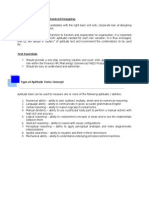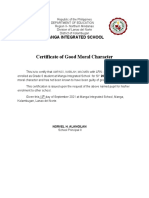0 ratings0% found this document useful (0 votes)
2 viewsSE104 - UID_2 Questions
Lecture 2 of SE104 focuses on UI design elements such as fonts, colors, and visual hierarchy, emphasizing the importance of creating a seamless and intuitive user experience. Key concepts include establishing a consistent font and color system to maintain brand identity and improve usability. The ultimate goal is to design an interface that feels invisible to users while ensuring engagement and functionality.
Uploaded by
ihab.sororCopyright
© © All Rights Reserved
Available Formats
Download as PDF, TXT or read online on Scribd
0 ratings0% found this document useful (0 votes)
2 viewsSE104 - UID_2 Questions
Lecture 2 of SE104 focuses on UI design elements such as fonts, colors, and visual hierarchy, emphasizing the importance of creating a seamless and intuitive user experience. Key concepts include establishing a consistent font and color system to maintain brand identity and improve usability. The ultimate goal is to design an interface that feels invisible to users while ensuring engagement and functionality.
Uploaded by
ihab.sororCopyright
© © All Rights Reserved
Available Formats
Download as PDF, TXT or read online on Scribd
You are on page 1/ 5
SE104 - UID_2 Questions
General Overview
1. What is the primary focus of Lecture 2 in SE104?
a. A) Advanced Backend Development
b. B) Fonts, Colors, and the Invisible UI
c. C) Software Testing
d. D) Database Optimization
Answer: B) Fonts, Colors, and the Invisible UI
2. What is meant by "The best UI is no UI"?
a. A) Removing the user interface entirely
b. B) Creating an interface that feels seamless and intuitive
c. C) Avoiding all visual hierarchy
d. D) Using plain text for all applications
Answer: B) Creating an interface that feels seamless and intuitive
3. What is the importance of defining a visual hierarchy in UI design?
a. A) It ensures all elements have equal prominence.
b. B) It directs user attention to the most important parts of the design.
c. C) It eliminates the need for typography.
d. D) It focuses only on color consistency.
Answer: B) It directs user attention to the most important parts of the design.
Fonts
4. Why is establishing a font system important in UI design?
a. A) To make the interface look unique for every user
b. B) To create consistency and maintain brand identity
c. C) To eliminate typography from designs
d. D) To reduce the need for color systems
Answer: B) To create consistency and maintain brand identity
5. What is the main difference between custom fonts and system fonts?
a. A) Custom fonts are pre-installed, while system fonts are downloaded.
b. B) Custom fonts allow for branding, while system fonts ensure compatibility.
c. C) System fonts are always more visually appealing.
d. D) Custom fonts eliminate the need for accessibility.
Answer: B) Custom fonts allow for branding, while system fonts ensure
compatibility.
6. What naming convention should be used for fonts in a font system?
a. A) Random names based on creativity
b. B) Descriptive and systematic names for clarity
c. C) Only numerical codes
d. D) Avoiding names altogether
Answer: B) Descriptive and systematic names for clarity
Colors
7. What is the role of a color system in UI design?
a. A) To ensure visual consistency and accessibility
b. B) To use as many colors as possible in a design
c. C) To limit user interaction with the interface
d. D) To prioritize aesthetics over functionality
Answer: A) To ensure visual consistency and accessibility
8. What is a benefit of establishing a consistent color system?
a. A) Reduces the time required for testing
b. B) Creates a recognizable and professional appearance
c. C) Limits the options for designers
d. D) Makes designs less functional
Answer: B) Creates a recognizable and professional appearance
9. Why is color hierarchy important in UI design?
a. A) It ensures colors are applied randomly.
b. B) It directs user focus and creates balance.
c. C) It avoids the use of specific color patterns.
d. D) It ensures equal prominence of all elements.
Answer: B) It directs user focus and creates balance.
Typography
10. What does typography focus on in UI design?
a. A) Simplifying backend logic
b. B) Balancing readability with aesthetic appeal
c. C) Reducing the importance of font selection
d. D) Avoiding visual hierarchy
Answer: B) Balancing readability with aesthetic appeal
11. What is an example of poor typography in UI design?
a. A) Using a consistent font system
b. B) Employing too many fonts in a single interface
c. C) Following clear naming conventions for fonts
d. D) Maintaining a logical visual hierarchy
Answer: B) Employing too many fonts in a single interface
The Invisible UI
12. What does "Invisible UI" aim to achieve?
a. A) Designs that users cannot see
b. B) Simplifying interactions for intuitive use
c. C) Avoiding graphical elements
d. D) Eliminating typography
Answer: B) Simplifying interactions for intuitive use
13. What is an example of an "Invisible UI"?
a. A) A cluttered webpage with numerous elements
b. B) A simple, self-explanatory design with minimal steps
c. C) A design focused solely on visual appeal
d. D) A webpage with only text and no visuals
Answer: B) A simple, self-explanatory design with minimal steps
Assignments
14. What assignment was provided in Lecture 2 related to typography?
a. A) Create a dynamic website
b. B) Design a business card with your own schema
c. C) Develop a mobile application
d. D) Build an e-commerce template
Answer: B) Design a business card with your own schema
15. What key elements should be included in the assignment on designing a business
card?
a. A) A font and color system
b. B) Backend logic and database
c. C) Advanced animations
d. D) A complex visual hierarchy
Answer: A) A font and color system
Additional Concepts
16. How do fonts, colors, and visual hierarchy contribute to UI design?
a. A) They improve user engagement and usability.
b. B) They reduce the need for backend logic.
c. C) They eliminate the need for testing.
d. D) They complicate the design process.
Answer: A) They improve user engagement and usability.
17. Which of the following is NOT a focus of Lecture 2?
a. A) Fonts
b. B) Colors
c. C) Typography
d. D) Database Management
Answer: D) Database Management
18. Why is consistency important in font and color systems?
a. A) It creates a visually appealing and professional interface.
b. B) It avoids the need for user testing.
c. C) It reduces the overall workload for developers.
d. D) It removes the need for design guidelines.
Answer: A) It creates a visually appealing and professional interface.
19. How does the course recommend balancing creativity and usability?
a. A) Prioritize creativity over functionality
b. B) Use established systems like font and color hierarchies
c. C) Focus only on the technical backend requirements
d. D) Avoid following standard design principles
Answer: B) Use established systems like font and color hierarchies
20. What is the ultimate goal of a well-designed UI?
a. A) To minimize user interaction
b. B) To make the interface invisible to users
c. C) To create a seamless, intuitive, and engaging experience
d. D) To focus primarily on aesthetics
Answer: C) To create a seamless, intuitive, and engaging experience
You might also like
- Detailed Lesson Plan in English I. Objectives100% (2)Detailed Lesson Plan in English I. Objectives9 pages
- Third Term Examination For Data Processing, CCA, Maths Treva's Academy100% (1)Third Term Examination For Data Processing, CCA, Maths Treva's Academy15 pages
- wdu202c-ui-design-wireframe-quiz-questions-and-answersNo ratings yetwdu202c-ui-design-wireframe-quiz-questions-and-answers104 pages
- Practice on MCQ & sentence completion (1)No ratings yetPractice on MCQ & sentence completion (1)5 pages
- What is the primary focus of identifying business requirements in a technical environmentNo ratings yetWhat is the primary focus of identifying business requirements in a technical environment4 pages
- Practical Strategies for Technical Communication 2nd Edition Markel Test Bankpdf download100% (2)Practical Strategies for Technical Communication 2nd Edition Markel Test Bankpdf download44 pages
- Visual Basic Programming Question Paper For InstituteNo ratings yetVisual Basic Programming Question Paper For Institute8 pages
- What is the primary goal of software reuse in software engineeringNo ratings yetWhat is the primary goal of software reuse in software engineering3 pages
- A Good Site Should Always Begin With The UserNo ratings yetA Good Site Should Always Begin With The User10 pages
- Вопросы для ГОС экзаменов для сайта Дизайн 3 курсNo ratings yetВопросы для ГОС экзаменов для сайта Дизайн 3 курс6 pages
- C# Programming Illustrated Guide For Beginners & Intermediates: The Future Is Here! Learning By Doing ApproachFrom EverandC# Programming Illustrated Guide For Beginners & Intermediates: The Future Is Here! Learning By Doing ApproachNo ratings yet
- (AC-S08) Week 08 - Pre-Task - Quiz - Weekly Quiz - INGLES IV (34349)No ratings yet(AC-S08) Week 08 - Pre-Task - Quiz - Weekly Quiz - INGLES IV (34349)5 pages
- Metaverse in Education Vision, Opportunities, and ChallengesNo ratings yetMetaverse in Education Vision, Opportunities, and Challenges10 pages
- LABREPORT1 IS216 Ramos Samuya Sison Yadao TumambingNo ratings yetLABREPORT1 IS216 Ramos Samuya Sison Yadao Tumambing6 pages
- Science 2 Detailed Lesson Plan For Educ 114No ratings yetScience 2 Detailed Lesson Plan For Educ 1149 pages
- Fred Swaniker On Leadership and EducationNo ratings yetFred Swaniker On Leadership and Education5 pages
- M B J L D E A: Oving Odies: Acques Ecoq AND Rama Ducation in UstraliaNo ratings yetM B J L D E A: Oving Odies: Acques Ecoq AND Rama Ducation in Ustralia10 pages
- LAB 03a-Manage Azure Resources by Using The Azure PortalNo ratings yetLAB 03a-Manage Azure Resources by Using The Azure Portal3 pages
- Research Topic The Impact of Talent Management On Job SatisfactionNo ratings yetResearch Topic The Impact of Talent Management On Job Satisfaction16 pages
- Certificate Achievement: Sample Learner 120 Hour Advanced TEFL CourseNo ratings yetCertificate Achievement: Sample Learner 120 Hour Advanced TEFL Course1 page
- Third Term Examination For Data Processing, CCA, Maths Treva's AcademyThird Term Examination For Data Processing, CCA, Maths Treva's Academy
- wdu202c-ui-design-wireframe-quiz-questions-and-answerswdu202c-ui-design-wireframe-quiz-questions-and-answers
- What is the primary focus of identifying business requirements in a technical environmentWhat is the primary focus of identifying business requirements in a technical environment
- Practical Strategies for Technical Communication 2nd Edition Markel Test Bankpdf downloadPractical Strategies for Technical Communication 2nd Edition Markel Test Bankpdf download
- Visual Basic Programming Question Paper For InstituteVisual Basic Programming Question Paper For Institute
- What is the primary goal of software reuse in software engineeringWhat is the primary goal of software reuse in software engineering
- Вопросы для ГОС экзаменов для сайта Дизайн 3 курсВопросы для ГОС экзаменов для сайта Дизайн 3 курс
- C# Programming Illustrated Guide For Beginners & Intermediates: The Future Is Here! Learning By Doing ApproachFrom EverandC# Programming Illustrated Guide For Beginners & Intermediates: The Future Is Here! Learning By Doing Approach
- (AC-S08) Week 08 - Pre-Task - Quiz - Weekly Quiz - INGLES IV (34349)(AC-S08) Week 08 - Pre-Task - Quiz - Weekly Quiz - INGLES IV (34349)
- Metaverse in Education Vision, Opportunities, and ChallengesMetaverse in Education Vision, Opportunities, and Challenges
- LABREPORT1 IS216 Ramos Samuya Sison Yadao TumambingLABREPORT1 IS216 Ramos Samuya Sison Yadao Tumambing
- M B J L D E A: Oving Odies: Acques Ecoq AND Rama Ducation in UstraliaM B J L D E A: Oving Odies: Acques Ecoq AND Rama Ducation in Ustralia
- LAB 03a-Manage Azure Resources by Using The Azure PortalLAB 03a-Manage Azure Resources by Using The Azure Portal
- Research Topic The Impact of Talent Management On Job SatisfactionResearch Topic The Impact of Talent Management On Job Satisfaction
- Certificate Achievement: Sample Learner 120 Hour Advanced TEFL CourseCertificate Achievement: Sample Learner 120 Hour Advanced TEFL Course

























































































